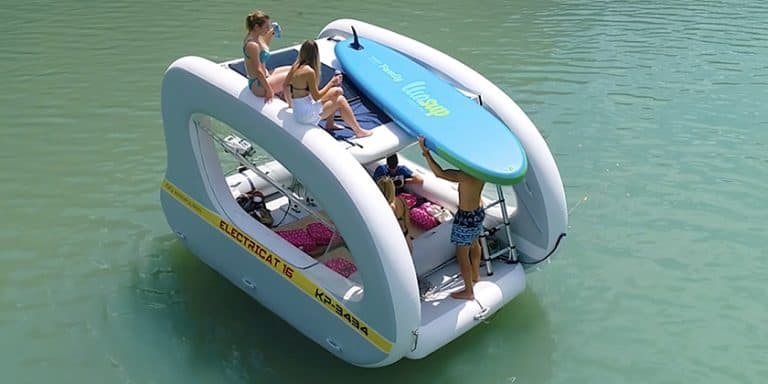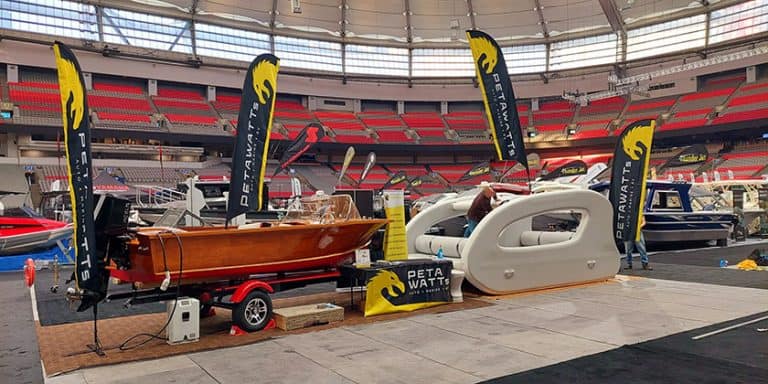Plugboats: Testing a compact electric dinghy
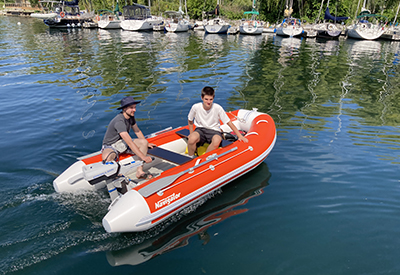
Sept 22, 2022
Two weeks ago, I got a call from a CBC radio reporter looking to do a story on electric boats and hoping to go out for a spin in one. That was the good news. The bad news was he called late on a Friday afternoon and wanted to do the item for a Tuesday show.
The best thing on short notice was to call Anatoli Shkliaruk of Navigator Boats, who specializes in folding RIBs and is also a dealer for the ePropulsion line of electric outboards.
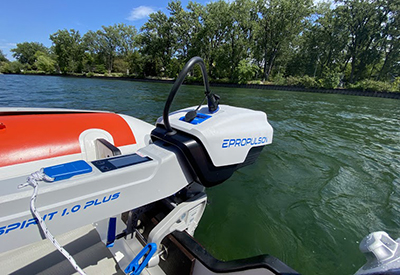 He was in but where to test? Fortunately, after a few phone calls, the Queen City Yacht Club came to the rescue. QCYC has a grand clubhouse built in 1921 situated right next to the Ward’s Island ferry docks and – most important for this mission – has an easily accessible ramp where we could set up the RIB and motor and set off onto the island lagoon and harbour waters.
He was in but where to test? Fortunately, after a few phone calls, the Queen City Yacht Club came to the rescue. QCYC has a grand clubhouse built in 1921 situated right next to the Ward’s Island ferry docks and – most important for this mission – has an easily accessible ramp where we could set up the RIB and motor and set off onto the island lagoon and harbour waters.
When Anatoli said that the 12-foot folding RIB, ePropulsion motor and battery would all fit into a smallish SUV, I was a little dubious. But when he arrived at the water taxi, there it was. The RIB fits into a travel bag slightly larger than a hockey bag – about 4.5 feet long and 2 feet square.
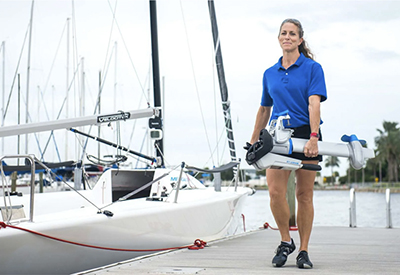
minus the battery, the motor is easy to carry
The ePropulsion he brought was the Spirit 1.0, which is roughly the power equivalent of a 3 horsepower. The motor itself weighs 11.3 kilograms and has a carrying bag 124 × 20 × 42 cm. The battery weighs in at 8.7 kilograms with a bag 30 × 20 × 42 cm. The two of us easily loaded RIB, motor and battery onto a watertaxi – although I did make Anatoli carry the big bag with the boat in it.
Over at the QCYC, we got things set up. The RIB inflates in a few minutes with a standard foot pump, with surprisingly little exertion required. Once inflated, we slipped it into the water and fit the electric motor to the transom. It attaches with thumbscrews just like any outboard. The light weight was appreciated again.
The next thing to do was to connect it to the battery. The ePropulsion, like a number of other small electric outboards including Torqeedo, have battery packs that click into place the same way a battery would click into an electric drill. A nice touch with the ePropulsion is that the battery is totally waterproof and floats. Luckily, we didn’t need that feature.
One of the key differences between a small electric outboard and a gas unit is that the motor of the electric version is actually under the water. From a distance, it looks like there is a powerhead at the top of the shaft, but that is the battery sitting in place.
Electric motors are naturally quieter than gas outboards because there are no explosions going on in any combustion chambers, and with the motor under the water it is even quieter.
When it came to the interview, in some ways an electric boat is perfect for radio because no one has to yell above the sound of the motor. On the other hand, without that sound there is no indication to the listener that the people talking are out on the water.
Cruising along the lagoon of the Toronto Islands we saw dozens of other inflatable dinghies tied up to sailboats at the QCYC and when we got back to the club we fielded some questions.
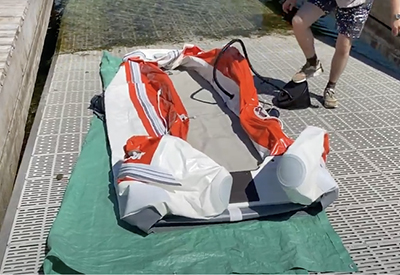 There are lots of boaters interested in electric motors, and some are even looking at replacing the diesels in their sailboats. The problem is that for most it doesn’t make financial sense to replace those motors when they are only used occasionally in a short boating season.
There are lots of boaters interested in electric motors, and some are even looking at replacing the diesels in their sailboats. The problem is that for most it doesn’t make financial sense to replace those motors when they are only used occasionally in a short boating season.
the small RIB inflates in a few minutes with a standard foot pump
The economics of a small electric outboard on a dinghy is a little easier to bear. For a quick comparison, a 5 or 6 HP gas motor is going to cost somewhere around $2,000 – $2,500. The ePropulsion 3.0 (a 5HP equivalent, bigger than what we took out) is $4,450 from Navigator.
Balancing the higher cost for the electric motor with the overall experience, the general feeling was that the quietness of the motor is nice, but the noise of a 5 hp isn’t exactly ear shattering. It was also a bonus that there were no fumes and emissions, but the thing that really seemed to appeal was the convenience and portability.
 For a sail of a few days or more with stops at harbours along the way, both the RIB and motor are small enough and light enough to store on board the ‘mothership’. The idea of not carrying a tank of gas was also appealing to some boaters.
For a sail of a few days or more with stops at harbours along the way, both the RIB and motor are small enough and light enough to store on board the ‘mothership’. The idea of not carrying a tank of gas was also appealing to some boaters.
A small electric motor on a dinghy has plenty of range – we toured around the harbour for about an hour for our interview and used less than half the charge. Recharging can be done at a regular marina pedestal, or you can use an onboard solar panel and never have to pay for any electricity at all.
As an electric boat enthusiast, I think that everybody should have one right now…but I know that’s not going to happen. The truth is that the technology isn’t there yet for many boaters and how they use their boat. For an extended cruise when you’d like a quick set-up dinghy for getting here and there, this may the way to go.
 Jeff Butler is based in Toronto and is the Editor/Publisher of plugboats.com, the international website covering everything electric boats and boating. He is also President of the Electric Boat Association of Canada and is busy preparing to bring electric motor boat racing and exhibitions to Toronto Harbour in 2023 for the first Toronto Solar Boat Races.
Jeff Butler is based in Toronto and is the Editor/Publisher of plugboats.com, the international website covering everything electric boats and boating. He is also President of the Electric Boat Association of Canada and is busy preparing to bring electric motor boat racing and exhibitions to Toronto Harbour in 2023 for the first Toronto Solar Boat Races.




